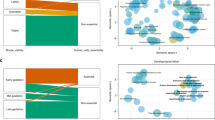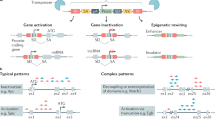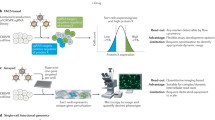Abstract
As the human genome project approaches completion, the challenge for mammalian geneticists is to develop approaches for the systematic determination of mammalian gene function. Mouse mutagenesis will be a key element of studies of gene function1,2,3. Phenotype-driven approaches using the chemical mutagen ethylnitrosourea4,5,6 (ENU) represent a potentially efficient route for the generation of large numbers of mutant mice that can be screened for novel phenotypes. The advantage of this approach is that, in assessing gene function, no a priori assumptions are made about the genes involved in any pathway. Phenotype-driven mutagenesis is thus an effective method for the identification of novel genes and pathways1,2. We have undertaken a genome-wide, phenotype-driven screen for dominant mutations in the mouse. We generated and screened over 26,000 mice, and recovered some 500 new mouse mutants. Our work, along with the programme reported in the accompanying paper7, has led to a substantial increase in the mouse mutant resource and represents a first step towards systematic studies of gene function in mammalian genetics.
This is a preview of subscription content, access via your institution
Access options
Subscribe to this journal
Receive 12 print issues and online access
$209.00 per year
only $17.42 per issue
Buy this article
- Purchase on Springer Link
- Instant access to full article PDF
Prices may be subject to local taxes which are calculated during checkout

Similar content being viewed by others
References
Peters, J. & Brown, S.D.M. Combining mutagenesis and genomics in the mouse—closing the phenotype gap. Trends Genet. 12, 433–435 (1996).
Brown, S.D.M. & Nolan, P.M. Mouse mutagenesis—systematic studies of mammalian gene function. Hum. Mol. Genet. 7, 1627–1633 (1998).
Justice, M., Noveroske, J.K., Weber, J.S., Zheng, B. & Bradley, A. Mouse ENU mutagenesis. Hum. Mol. Genet. 8, 1955–1963 (1999).
Russell, W.L. et al. Specific locus test shows ethylnitrosourea to be the most potent mutagen in the mouse. Proc. Natl Acad. Sci. USA 76, 5918–5922 (1979).
Shedlovsky, A, McDonald, J.D., Symula, D. & Dove, W.F. Mouse models of human phenylketonuria. Genetics 134, 1205–1210 (1993).
Rinchik, E.M. & Carpenter, D.A. N-ethyl-N-nitrosourea mutagenesis of a 6- to 11-cM subregion of the Fah-Hbb interval of mouse chromosome 7: completed testing of 4,557 gametes and deletion mapping and complementation analysis of 31 mutations. Genetics 152, 373–383 (1999).
Hrabe de Angelis, M. et al. Genome-wide, large-scale production of mutant mice by ENU mutagenesis. Nature Genet. 25, 444–447 (2000).
Rogers, D.C. et al. Behavioural and functional analysis of mouse phenotype: SHIRPA, a proposed protocol for comprehensive phenotype assessment. Mamm. Genome 8, 711–713 (1997).
Geyer, M.A. & Braff, D.L. Startle habituation and sensorimotor gating in schizophrenia and related animal models. Schizophr. Bull. 13, 643–668 (1987).
Thornton, C.E., Brown, S.D.M. & Glenister, P.H. Large numbers of mice established by in vitro fertilisation with cryopreserved spermatazoa: implications and applications for genetic resource banks, mutagenesis screens and mouse backcrosses. Mamm. Genome 10, 987–992 (1999).
Nolan, P.M. et al. Heterozygosity mapping of partially congenic lines: mapping of a semi-dominant neurological mutation, wheels (Whl), on mouse chromosome 4. Genetics 140, 245–254 (1995).
Medical Research Council Responsibility In the Use of Animals for Medical Research (Medical Research Council, London, 1993).
Nolan, P.M., Kapfhamer, D. & Bucan, M. Random mutagenesis screen for dominant behavioural mutations in mice. Methods 13, 379–395 (1997).
Irwin, S. Comprehensive observational assessment: 1a. A systematic, quantitative procedure for assessing the behavioural and physiologic state of the mouse. Psychopharmacalogica 13, 222–257 (1968).
Candy, C.J., Wood, M.J. & Whittingham, D.G. Effect of cryoprotectants on the survival of follicles in frozen mouse ovaries. J. Reprod. Fert. 110, 1–19 (1997).
Acknowledgements
We thank A. Jordan, N. Chobrot, K. Arnold, N. Sear, A. Parker, J. Airey,M. Boatfield, S. Mansell, C. Johns, S. Clements, A. Nash, S. Smythe, I. Latham, K. Doncaster, C. Parsons and L. Rooke for technical assistance. This work was supported by the Medical Research Council, SmithKline Beecham, the European Union, the Motor Neuron Disease Association and the Birth Defects Foundation.
Author information
Authors and Affiliations
Corresponding author
Rights and permissions
About this article
Cite this article
Nolan, P., Peters, J., Strivens, M. et al. A systematic, genome-wide, phenotype-driven mutagenesis programme for gene function studies in the mouse. Nat Genet 25, 440–443 (2000). https://doi.org/10.1038/78140
Received:
Accepted:
Issue Date:
DOI: https://doi.org/10.1038/78140
This article is cited by
-
Genetically modified mice as a tool for the study of human diseases
Molecular Biology Reports (2024)
-
Progress towards completing the mutant mouse null resource
Mammalian Genome (2022)
-
gom1 Mutant Mice as a Model of Otitis Media
Journal of the Association for Research in Otolaryngology (2022)
-
Mice with an autosomal dominant Charcot-Marie-Tooth type 2O disease mutation in both dynein alleles display severe moto-sensory phenotypes
Scientific Reports (2019)



